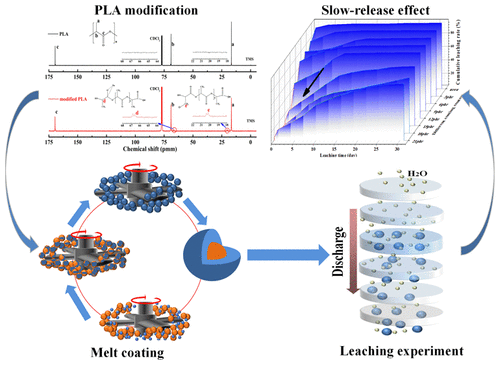当前位置:
X-MOL 学术
›
Ind. Eng. Chem. Res.
›
论文详情
Our official English website, www.x-mol.net, welcomes your feedback! (Note: you will need to create a separate account there.)
Low-Temperature Flowable Poly(lactic acid)/Polycaprolactone Blends for the Solvent-Free Preparation of Slow-Released Urea Fertilizer in a Thermal Shear Field
Industrial & Engineering Chemistry Research ( IF 4.2 ) Pub Date : 2020-11-16 , DOI: 10.1021/acs.iecr.0c04419 Xiaosong Xia 1 , Feng Zhang 1 , Le Yang 2 , Xiaolong Li 1 , Jun Wang 1 , Changkai Linghu 1 , Zhu Luo 1
Industrial & Engineering Chemistry Research ( IF 4.2 ) Pub Date : 2020-11-16 , DOI: 10.1021/acs.iecr.0c04419 Xiaosong Xia 1 , Feng Zhang 1 , Le Yang 2 , Xiaolong Li 1 , Jun Wang 1 , Changkai Linghu 1 , Zhu Luo 1
Affiliation

|
This work reports a convenient and large-scale method for the preparation of slow-release urea by melt coating with modified poly(lactic acid) (PLA)/polycaprolactone blends at low temperatures. The simple process is environmentally friendly and solvent-free, which can realize the industrial production of coated fertilizers. After being modified by ferric chloride, the crystallinity and molecular weight of poly(lactic acid) (PLA) are greatly reduced and the melt fluidity of PLA is improved. The lowest melting flowable temperatures of the PLA-modified blend was decreased to 115 °C, enabling the melt coating of urea particles using a mechanical stirrer. Because of the good compatibility of PLA with urea, a complete coating layer was formed on the surface of the urea particles by simple mixing at 120 °C, and the change of coating content has a great impact on the release effect. For the slow-release urea melt-coated with 18 phr of the blend, the time of the maximum release rate was delayed significantly and the cumulative release rate was 80.63% after 28 days in soil column leaching. When the coated granular slow-release urea was hot-pressed into a large cylinder, the slow-release effect was further enhanced. Simultaneously, with the massive use of PLA, its waste disposal becomes especially important, preparation of slow-release urea by melt-coating in this environmentally friendly manner needs to adjust the molecular weight and crystallinity of PLA, and its performance requirements are low. The work in this paper may provide a new approach for the recycling and reuse of waste PLA.
中文翻译:

低温可流动的聚乳酸/聚己内酯共混物,用于在热剪切场中无溶剂制备缓释尿素肥料
这项工作报告了一种方便且大规模的方法,该方法可通过在低温下用改性聚乳酸(PLA)/聚己内酯共混物进行熔融涂覆来制备缓释尿素。工艺简单,环保,无溶剂,可实现包膜肥料的工业化生产。经氯化铁改性后,聚乳酸(PLA)的结晶度和分子量大大降低,PLA的熔体流动性得到改善。PLA改性共混物的最低熔融流动温度降至115°C,从而可以使用机械搅拌器熔融涂覆尿素颗粒。由于PLA与尿素的良好相容性,只需在120°C下混合即可在尿素颗粒表面形成完整的涂层,包衣含量的变化对脱模效果有很大影响。对于18 phr共混物熔融包裹的缓释尿素,在土壤柱浸出28天后,最大释放速率的时间明显延迟,累积释放率为80.63%。将包衣的粒状缓释尿素热压成大圆筒时,缓释效果进一步增强。同时,随着PLA的大量使用,其废物处理变得尤为重要,以这种环境友好的方式通过熔融涂覆制备缓释尿素需要调节PLA的分子量和结晶度,并且其性能要求低。本文的工作可能为废物PLA的回收和再利用提供一种新方法。对于18 phr共混物熔融包裹的缓释尿素,在土壤柱浸出28天后,最大释放速率的时间明显延迟,累积释放率为80.63%。将包衣的粒状缓释尿素热压成大圆筒时,缓释效果进一步增强。同时,随着PLA的大量使用,其废物处理变得尤为重要,以这种环境友好的方式通过熔融涂覆制备缓释尿素需要调节PLA的分子量和结晶度,并且其性能要求低。本文的工作可能为废物PLA的回收和再利用提供一种新方法。对于18 phr共混物熔融包裹的缓释尿素,在土壤柱浸出28天后,最大释放速率的时间明显延迟,累积释放率为80.63%。将包衣的粒状缓释尿素热压成大圆筒时,缓释效果进一步增强。同时,随着PLA的大量使用,其废物处理变得尤为重要,以这种环境友好的方式通过熔融涂覆制备缓释尿素需要调节PLA的分子量和结晶度,并且其性能要求低。本文的工作可能为废物PLA的回收和再利用提供一种新方法。在土壤柱中淋洗28天后占63%。将包衣的粒状缓释尿素热压成大圆筒时,缓释效果进一步增强。同时,随着PLA的大量使用,其废物处理变得尤为重要,以这种环境友好的方式通过熔融涂覆制备缓释尿素需要调节PLA的分子量和结晶度,并且其性能要求低。本文的工作可能为废物PLA的回收和再利用提供一种新方法。在土壤柱中淋洗28天后占63%。将包衣的粒状缓释尿素热压成大圆筒时,缓释效果进一步增强。同时,随着PLA的大量使用,其废物处理变得尤为重要,以这种环境友好的方式通过熔融涂覆制备缓释尿素需要调节PLA的分子量和结晶度,并且其性能要求低。本文的工作可能为废物PLA的回收和再利用提供一种新方法。以这种环境友好的方式通过熔融涂覆制备缓释尿素需要调节PLA的分子量和结晶度,并且其性能要求低。本文的工作可能为废物PLA的回收和再利用提供一种新方法。以这种环境友好的方式通过熔融涂覆制备缓释尿素需要调节PLA的分子量和结晶度,并且其性能要求低。本文的工作可能为废物PLA的回收和再利用提供一种新方法。
更新日期:2020-11-25
中文翻译:

低温可流动的聚乳酸/聚己内酯共混物,用于在热剪切场中无溶剂制备缓释尿素肥料
这项工作报告了一种方便且大规模的方法,该方法可通过在低温下用改性聚乳酸(PLA)/聚己内酯共混物进行熔融涂覆来制备缓释尿素。工艺简单,环保,无溶剂,可实现包膜肥料的工业化生产。经氯化铁改性后,聚乳酸(PLA)的结晶度和分子量大大降低,PLA的熔体流动性得到改善。PLA改性共混物的最低熔融流动温度降至115°C,从而可以使用机械搅拌器熔融涂覆尿素颗粒。由于PLA与尿素的良好相容性,只需在120°C下混合即可在尿素颗粒表面形成完整的涂层,包衣含量的变化对脱模效果有很大影响。对于18 phr共混物熔融包裹的缓释尿素,在土壤柱浸出28天后,最大释放速率的时间明显延迟,累积释放率为80.63%。将包衣的粒状缓释尿素热压成大圆筒时,缓释效果进一步增强。同时,随着PLA的大量使用,其废物处理变得尤为重要,以这种环境友好的方式通过熔融涂覆制备缓释尿素需要调节PLA的分子量和结晶度,并且其性能要求低。本文的工作可能为废物PLA的回收和再利用提供一种新方法。对于18 phr共混物熔融包裹的缓释尿素,在土壤柱浸出28天后,最大释放速率的时间明显延迟,累积释放率为80.63%。将包衣的粒状缓释尿素热压成大圆筒时,缓释效果进一步增强。同时,随着PLA的大量使用,其废物处理变得尤为重要,以这种环境友好的方式通过熔融涂覆制备缓释尿素需要调节PLA的分子量和结晶度,并且其性能要求低。本文的工作可能为废物PLA的回收和再利用提供一种新方法。对于18 phr共混物熔融包裹的缓释尿素,在土壤柱浸出28天后,最大释放速率的时间明显延迟,累积释放率为80.63%。将包衣的粒状缓释尿素热压成大圆筒时,缓释效果进一步增强。同时,随着PLA的大量使用,其废物处理变得尤为重要,以这种环境友好的方式通过熔融涂覆制备缓释尿素需要调节PLA的分子量和结晶度,并且其性能要求低。本文的工作可能为废物PLA的回收和再利用提供一种新方法。在土壤柱中淋洗28天后占63%。将包衣的粒状缓释尿素热压成大圆筒时,缓释效果进一步增强。同时,随着PLA的大量使用,其废物处理变得尤为重要,以这种环境友好的方式通过熔融涂覆制备缓释尿素需要调节PLA的分子量和结晶度,并且其性能要求低。本文的工作可能为废物PLA的回收和再利用提供一种新方法。在土壤柱中淋洗28天后占63%。将包衣的粒状缓释尿素热压成大圆筒时,缓释效果进一步增强。同时,随着PLA的大量使用,其废物处理变得尤为重要,以这种环境友好的方式通过熔融涂覆制备缓释尿素需要调节PLA的分子量和结晶度,并且其性能要求低。本文的工作可能为废物PLA的回收和再利用提供一种新方法。以这种环境友好的方式通过熔融涂覆制备缓释尿素需要调节PLA的分子量和结晶度,并且其性能要求低。本文的工作可能为废物PLA的回收和再利用提供一种新方法。以这种环境友好的方式通过熔融涂覆制备缓释尿素需要调节PLA的分子量和结晶度,并且其性能要求低。本文的工作可能为废物PLA的回收和再利用提供一种新方法。



























 京公网安备 11010802027423号
京公网安备 11010802027423号